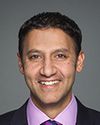Exactly.
I think that exhibition in pluralism is very much at the heart of what we as a museum stand for. When it came to the Syrian crisis, we all remember what happened at the end of 2015 moving into 2016 with the influx of Syrian refugees into this country. I think it was a very important moment in this country's history, because while many refugees have come to this country, the case of the Syrians was one of the most poignant of all, given the civil war that was raging and also the doors that were closing. Canada opened its doors.
As a museum we decided to respond to that in a very short period of time by coming up with an exhibition that looked at the cultural diversity of Syria. Part of the reason for us doing this is that with 40,000 refugees coming into the country, we wanted people to understand who Syrians were. We didn't want them simply typecast as being Syrians, refugees.
We wanted people to realize that if you look at their past, over 5,000 years, Syrians are Greeks, Romans, Babylonians, Mesopotamians, Byzantines, Malmuts, and so on and so forth. That cultures that are part of Syria are so diverse and people who are Syrian are diverse. That's something I think as a museum and museums in general should be able to grasp and showcase, because what other public institution can do this?
For us we felt it was very important to showcase that. to address an issue that was burning at that very moment. Again, if I think if you can show people what diversity and pluralism is that's the beginning of learning, understanding and getting people to think outside of the box.




